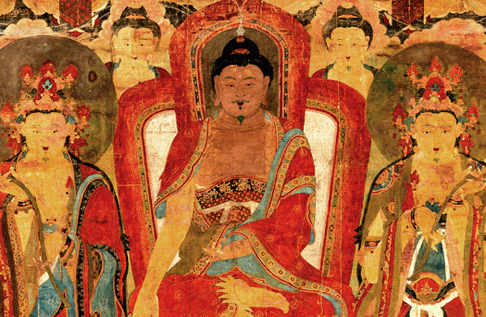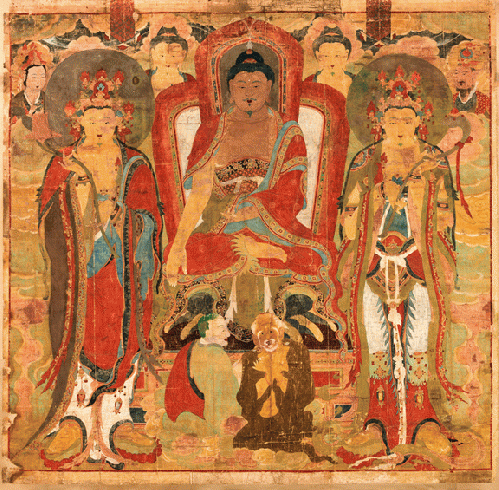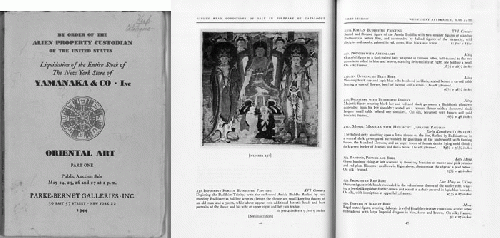Amidst a host of international battles over the ownership of plundered artworks, a small museum in Virginia is doing the right thing by repatriating a priceless piece of religious art.
Norfolk's Hermitage Museum & Gardens has just given a rare 18th century Buddhist painting on fabric from its collection to the National Museum of Korea. The Hermitage Museum was founded by William and Florence Sloane in 1937 and opened to the public in 1942.
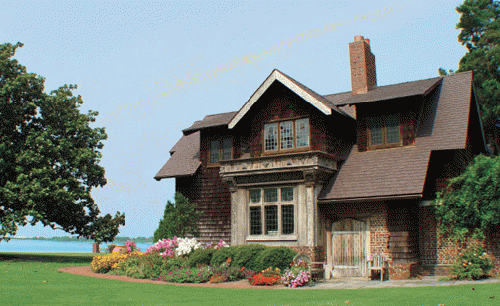
Hermitage Museum and Gardens, Norfok, VA
(Image by Courtesy of the Hermitage Museum and Gardens) Details DMCA
The Sloane's collection of fine and decorative art spans 5,000 years, represents 30 countries and includes over 5,000 objects. The collection is housed in their former home, a 42-room Arts and Crafts mansion on the shore of the Lafayette River in Norfolk, Virginia. Approximately 20% of the collection is Asian art.
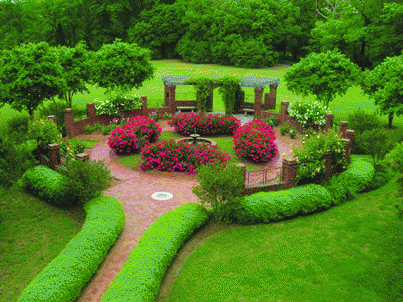
Hermitage Museum and Gardens, Norfok, VA
(Image by Courtesy of the Hermitage Museum and Gardens) Details DMCA
The Korean Sakyamuni Triad Painting's century-long, circuitous journey was finally completed when it was returned to Korea with the assistance of the Overseas Korean Cultural Heritage Foundation (OKCHF). The focus of the OKCHF is to preserve and protect Korean art, and to reclaim some of the art which was plundered during the Japanese occupation. The 10-foot by 10-foot painting depicts Buddha delivering a sermon to his followers. Unlike other images of the time, Buddha's disciples are not positioned behind him, but are depicted sitting in front of him in rapt attention. OKCHF Chairman AHN Hwi-joon notes that, "this tapestry depicts the Buddha in a deeply moving way that touches the hearts of viewers," and (it) "should be designated as a National Treasure."
Colin Brady, Chief Curator at the Hermitage, accompanied the 18th century Korean Sakyamuni Triad painting on its return to South Korea in December, 2013. He noted that the "estimated value of the work is about $200,000, and the cost of restoration will be between $70,000 and $100,000. It will take close to two years to complete the restoration."

Brady with Chairman Ahn Hwi Joon. The document recognizes the repatriation.
(Image by Courtesy of the OKCHF) Details DMCA
Following restoration, the painting will remain in Korea permanently, on display at the museum. Funding for the restoration is being provided by OKCHF, the Korean museum, and internationally-known League of Legends creator Riot Games.
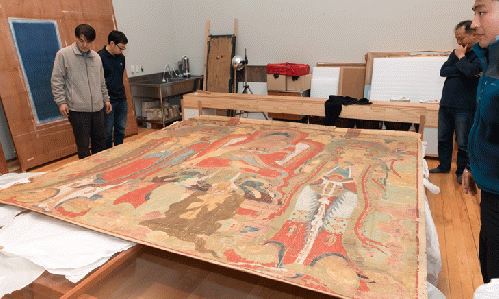
The painting is inspected in the conservatory, Nat'l Museum of Korea (Seoul)
(Image by Courtesy of the OKCHF) Details DMCA
This Buddha's journey began during the colonial occupation of Korea from 1910-1945, when Japan plundered tens of thousands of pieces of Korea's artistic treasures. Asian art dealership, Yamanaka & Company, Inc., was one of the primary providers of Asian antiquities to the west, and had offices in New York, Beijing, Osaka and London. Some time prior to 1940, one of its employees removed this painting from a Korean Buddhist temple by cutting it out of its frame and rolling it up.
By 1943, Yamanaka & Company was in the process of liquidation and the painting had changed hands to NYC's Parke-Bernet Galleries. It was included in two auctions first for $6,000.00 and later for $2,000.00, but remained unsold. Finally, in May of 1944 it was purchased at auction by Florence Sloane for $450.
Upon the painting's arrival in Norfolk it was discovered that it was too large for any of the galleries in the museum, so it remained in storage. In 1954, it was loaned to the Norfolk Museum of Arts and Sciences, (now the Chrysler Museum) where it hung in the grand stairwell for nearly 20 years. In 1973 it was returned to the Hermitage and stored again for over 25 years, until the Hermitage had it appraised and began to consider restoration.
Brady notes that in 2013 the OKCHF stumbled upon the artwork on an endangered object website associated with the Virginia Association of Museums. In November of 2013 Kim Young-Eun, Promotion & PR Division Director for the OKCHF, and other representatives from OKCHF visited the Hermitage to inspect the painting.
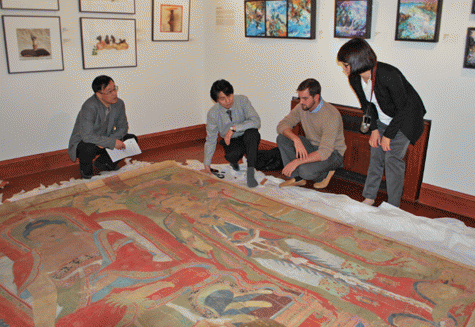
Brady (2nd from right) with members of the OKCHF, at the Hermitage.
(Image by Courtesy of the Hermitage Museum and Gardens) Details DMCA
The museum and the OKCHF crafted an agreement in which the Hermitage would give the painting back to the Republic of Korea with the understanding that it would be restored and displayed in the National Museum.
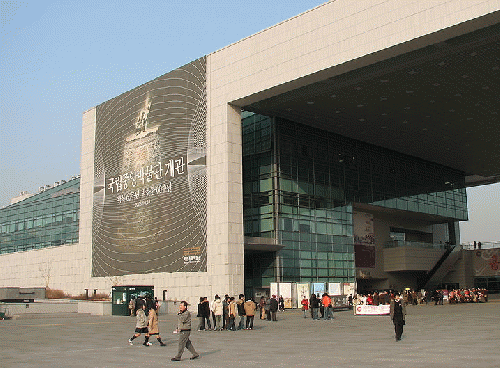
National Museum of Korea
(Image by (From Wikimedia) sarahkim (A Flickr user), Author: sarahkim (A Flickr user)) Details Source DMCA
The OKCHF revealed the painting at a press conference the National Museum of Korea on January 7, 2014.
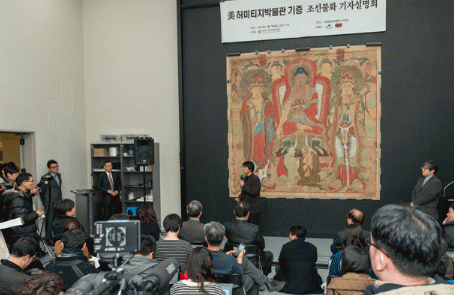
The press conference reveal at the National Museum of Korea
(Image by Courtesy of the OKCHF) Details DMCA
Brady was very excited about the return of the artwork to its original home, saying, "the repatriation of this Buddhist painting to the Republic of Korea is a defining moment for our institution. In an effort to act as good stewards towards our collection we feel that this return will provide the painting with a home where it can be appreciated not only as a work of art, but also as a demonstration of goodwill between two nations that are passionate about the care of cultural properties. There is no doubt in my mind that we are honoring the integrity of our founder, Florence Sloane, and her vision of the Hermitage engaging with all cultures through artistic diplomacy. We look forward to seeing the piece restored and on exhibit in the future."
The Hermitage's Buddha In Context: Plundered Art in Wartime & Colonialization
Art repatriation is a complex and convoluted subject, with attitudes ranging from "to the victors go the spoils" to adherence to the steadfast return of all looted art to the country of origin or former owners (or heirs). Others point out that fulfilling all restitution claims would empty most of the world's great museums.
In addition, some art pieces from antiquity have been replundered so many times that it is not possible to determine an original owner.
For example, in 1873 a cache of gold and other artifacts considered to be one of the most important finds from the Central European Bronze Age was discovered in Turkey by archaeologist Heinrich Schliemann. The Eberswalde Hoard, also dubbed "Priam's Treasure" and including the "Jewels of Helen," was discovered at a location believed to be the site of ancient Troy.
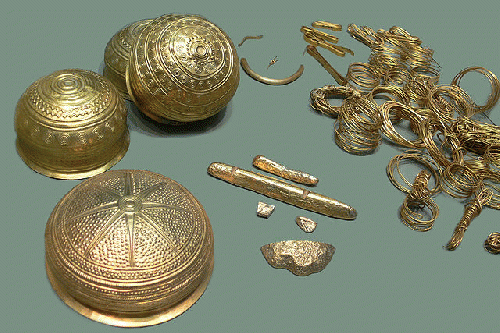
The Eberswalde Hoard disappeared from Germany in 1945
(Image by (From Wikimedia) Photograph: Andreas Praefcke, Author: Photograph: Andreas Praefcke) Details Source DMCA
Schliemann apparently smuggled the collection out to Germany, where most of it remained in the hands of the Royal Museums of Berlin until it disappeared in 1945. The Soviet Union denied any involvement, but in September 1993 the treasure turned up at the Pushkin Museum in Moscow. While Germany and Russia battle it out, one can hardly help wondering about possible claims by Turkey, or even Greece.
Russia estimates that about two million works of art were stolen by the Germans during their short-lived occupation of western Russia. American museums alone have identified 16,000 objects in their possession that may have been seized by the Nazis.
The Amber Room, sometimes dubbed the "Eighth Wonder of the World," was removed from Catherine Palace, Saint Petersburg, by the Nazis and transported to Germany. Knowledge of its location has been lost, and evidents points to its destruction in a fire in April 1945. Painstakingly crafted by a team of extraordinary artisans for over a decade, it contained over six tons of amber. The adjusted estimated value is $142 million.
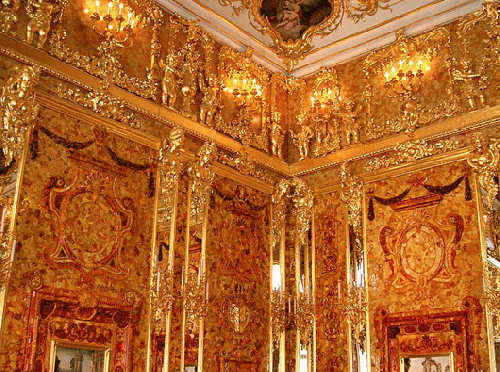
The Amber Room of the Catherine Palace (Reconstruction)
(Image by (From Wikimedia) jeanyfan, Author: jeanyfan) Details Source DMCA
Below, General Dwight D. Eisenhower, Supreme Allied Commander, accompanied by Gen. Omar N. Bradley, and Lt. Gen. George S. Patton, Jr., inspect art treasures stolen by Germans and hidden in a salt mine in Germany.
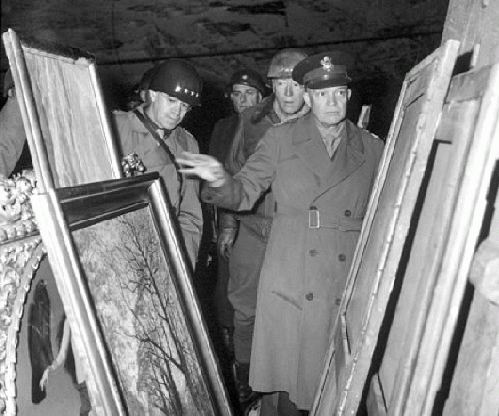
Eisenhower, Bradley and Patton inspect art looted by the Nazis
(Image by (From Wikimedia) Lt. Moore, U.S. Army, Author: Lt. Moore, U.S. Army) Details Source DMCA
Meanwhile, Germany has been angrily insisting that Russia return a vast trove of art looted at the end of World War II, including "Priam's Treasure."
Poland has demanded billions in compensation for cultural artifacts stolen or destroyed during the Nazi occupation.
The iconic Bust of Nefertiti is a 3,300-year-old painted limestone image of the Great Royal Wife of the Egyptian Pharaoh Akhenaten. It was taken from Egypt under questionable circumstances, and Egypt wants it returned from its current home in a Berlin Museum.
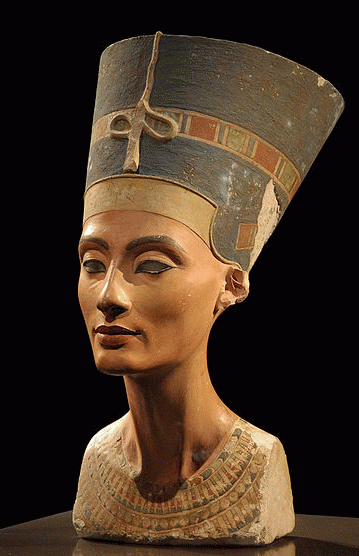
The iconic bust of Nefertiti
(Image by (From Wikimedia) Philip Pikart, Author: Philip Pikart) Details Source DMCA
Egypt also wants the Rosetta Stone back from the British Museum.
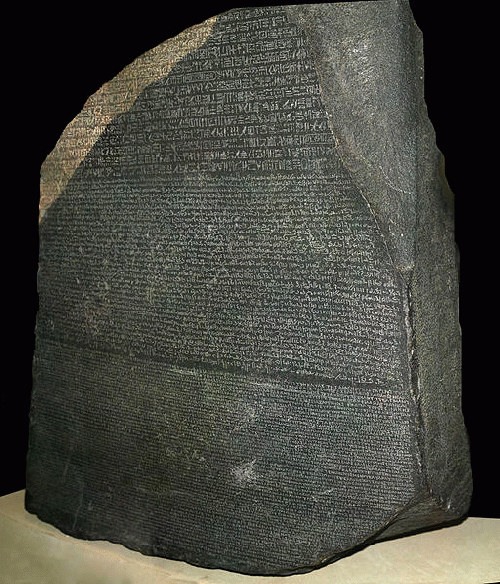
The Rosetta Stone, British Museum
(Image by (Not Known) © Hans Hillewaert / CC-BY-SA-3.0 via wiki, Author: Author Not Given) Details Source DMCA
Spanish conquistadors couldn't get enough of Aztec gold, and sent shiploads of "primitive" gold artifacts back to Europe. What wasn't melted down is now scattered around the world in many museums.
Seventy-five percent of all the Italian art in the Louvre is a result of Napoleon's sweeping plunder of Italy. Napoleon noted, "We will now have all that is beautiful in Italy except for a few objects in Turin and Naples."
The Parthenon Marbles is a collection of classical Greek marble sculptures and bas-reliefs that were forcably ripped off the Parthenon and other buildings on the Acropolis by Lord Elgin and his accomplices. They are also known as the Elgin Marbles, although it seems disrespectful to name them after their rapist-kidnapper.
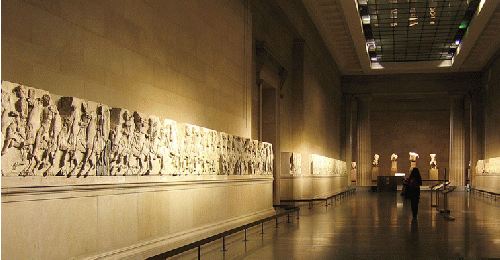
The room containing the Elgin Marbles in the British Museum.
(Image by (Not Known) Andrew Dunn, cc license via wiki, Author: Author Not Given) Details Source DMCA
From 1801 to 1812, Elgin removed half of the then-surviving sculptures of the Parthenon and shipped them back to England. These priceless antiquities were not only damaged during their removal, a ship full of them sank in the Mediterranean. These were later laboriously retrieved, but not without damage. The ones that made it back to London were damaged by pollution. At the time, Lord Byron and others accused Elgin of looting. (And in order to pay for plundering these treasures from Greece, he looted his wife's fortune.)
The Marbles now reside in the British Museum. The legality of their removal from Athens is hotly debated, and Greece wants them back, but there it little hope for their return.
A horrifying recent case involved the looting of priceless ancient Babylonian, Sumerian and Assyrian artifacts from the National Museum of Iraq in Baghdad at the outbreak of the war in 2003. The museum was vacated on April 8. When staff returned four days later, they were shocked to discover an estimated 15,000 items were stolen. The museum had been unguarded despite the museum's earlier procurement of an American promise to protect these irreplaceable antiquities from the Cradle of Civilization.
Since many of the museums who now own plundered art refuse to consider repatriation, a number of international legal battles are ongoing.
But as bad as the unrepentant museums and shameless plunderers are, at least they are more respectful of the art than the Christians, who have a bad habit of destroying any art that does not conform to their particular brand of religious dogma. They had a penchant for lopping off the noses, ears, fingers, and any other protrusions (yes, those too!) of classical statuary. (Did you think all those museum statues were missing appendages because they just happened to bump into something?) Those insolent Christians even left a trail linking them to their evil deeds since they baptized many of the statues with crosses carved into the foreheads.
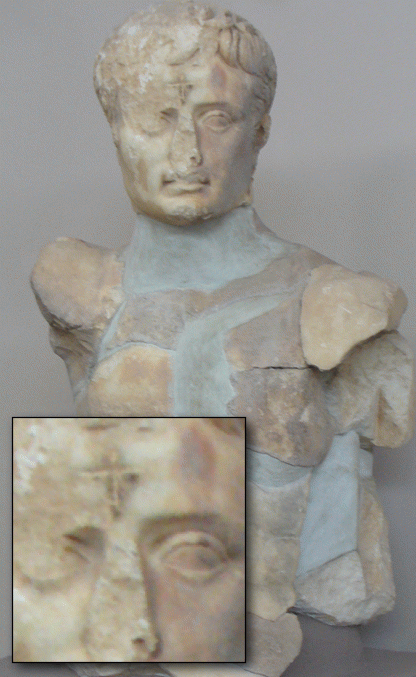
Augustus of Ephesus disfigured by self-righteous Christian art-mutilators
(Image by (From Wikimedia) QuartierLatin1968, Author: QuartierLatin1968) Details Source DMCA
One hopes that the rest of the world will take a cultural cue from museums like the Hermitage Museum and Gardens, and participate more fully in protecting, preserving and respecting the world's artistic treasures.
For, these priceless works of beauty, skill and inspiration transcend capricious boundaries as they enrich the world, and as pinnacles of wonder they truly belong to all humankind.
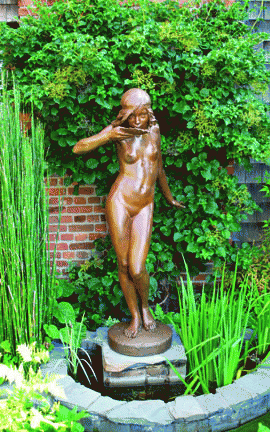
Hermitage Museum and Gardens, Norfok, VA
(Image by Courtesy of the Hermitage Museum and Gardens) Details DMCA
The Hermitage Museum & Gardens sits on a 12-acre site in Norfolk, on a peninsula of land that juts out into the Lafayette River. The museum offers exhibitions, outdoor movies and concerts, a summer art camp for children, year-round classes and workshops, visiting artists studios, wetlands reclamation projects and education, beautiful grounds, gardens and wooded walking trails, and is a popular location for weddings and private events. Open daily 10-5, Sundays 1-5, closed Wednesdays and Thursdays. It is free to visit the grounds, and admission to the museum is free for Museum Members, children under 6, and Active Duty military, $5 for Adults, $2 for ages 6-18, and $3 for students. For more information on the museum and membership offerings call 757-423-2052 or visit thehermitagemuseum.org



